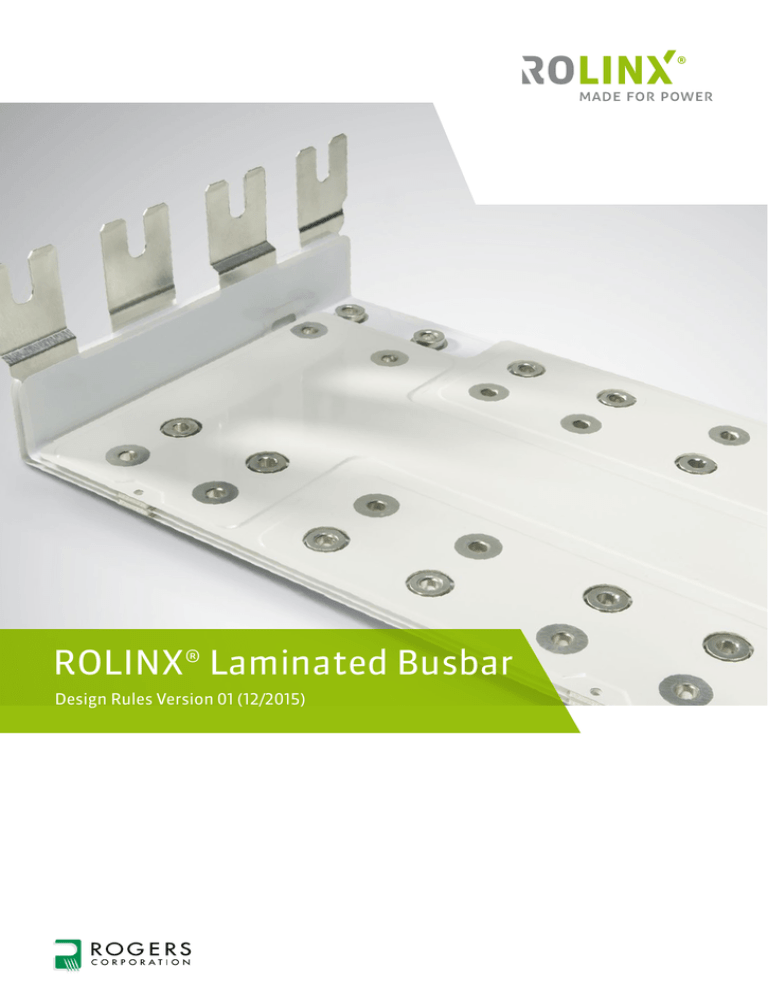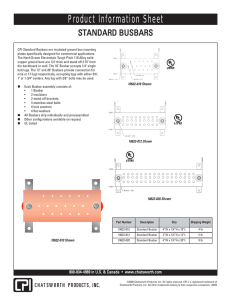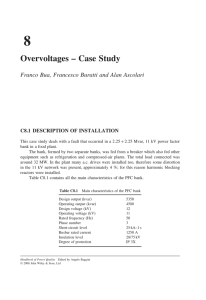
ROLINX® Laminated Busbar
Design Rules Version 01 (12/2015)
Content
1. Introduction ................................................................... 03
7. Features........................................................................... 13
2. Configuration...................................................................03
8. Thermal parameters......................................................... 14
3. Products......................................................................... 04
9. General parameters......................................................... 14
4. Material.......................................................................... 06
10. Test specification........................................................... 14
4.1. Conductor......................................................................... 06
4.2. Insulation........................................................................ 07
11. Labelling......................................................................... 14
4.2.1. Outer film insulations................................................... 07
4.2.2. Inner film insulations................................................... 08
12. Glossary.......................................................................... 15
4.2.3. Inner rigid insulations.................................................. 08
4.3. Plating.............................................................................. 09
5. Electrical parameters....................................................... 10
5.1. Current..............................................................................10
5.2. Voltage..............................................................................10
5.3. Clearance distance...........................................................10
5.4. Creepage distance............................................................ 11
5.5. Partial discharge............................................................... 11
6. Mechanical parameters ................................................... 12
6.1. Physical dimensions and tolerances................................12
6.2. Bending.............................................................................13
13. Standards....................................................................... 15
1. Introduction
This document shall be used as a guideline for those who are involved in the design and specification of laminated busbars.
The guideline provides general information that should be considered for a typical busbar design.
2. Configuration
The busbars are available in the following configurations:
// Single layer – consisting of a single conductor that is either insulated or un-insulated
// Multi-layer – consisting of two or more conductors that are separated by insulation layers
The multi-layers configuration can be also insulated or un-insulated on the outside layer of the conductor.
There are many configurations for different insulation configurations and sealing methods.
For the outside insulations the following options are available:
// Flexible polyester film (PET)
// Polyimide film (PI)
For the inner insulation the following options are available:
// Flexible polyester film (PET)
// Rigid glass matt reinforced polyester (DM1)
// Rigid glass cloth epoxy material (FR4)
The following technics for the edge insulation are available:
// Open mould – no sealing
// Closed mould – sealed mould/edge
// Potting
Open mould
Closed mould
Potting
ROLINX® Laminated Busbar I Design Guide I Version 01
03
3. Products
Rogers is offering the following products for laminated busbars:
//
ROLINX® Easy is designed for low and medium voltage applications with lower electrical performance requirements. ROLINX Easy is a laminated busbar solution without outer insulation and a closed mould technology, offering high short circuit resistance, optimized inductivity and high currents above 1000A.
// High short circuit resistance and low inductivity
// A cost effective alternative for stacked busbars
// Manufactured in a controlled production process
// The ease of use helps to reduce installation times
//
ROLINX® Performance is designed for medium and high voltage application and in combination with high currents over 1000A. ROLINX Performance is a laminated busbar that offers all material, lamination and plating configurations with optimized inductance and design for controlling of partial discharge.
// Provides optimized inductance
// Designed for controlling partial discharge
// Shaped to fit high voltage applications
// Proven technology
// ROLINX® Thermal is an evolution of ROLINX Performance offering increased working temperature up
to 125°C.
// Developed to get more power from the
existing system and design
// Extended thermal characteristics: up to 125°C
// Extended humidity rating
// Designed to last
04
ROLINX® Laminated Busbar I Design Guide I Version 01
//
ROLINX® Hybrid is designed as one piece solution that combines power and signal lines. ROLINX Hybrid is a laminated busbar for low voltage applications like battery cell connection in Electrical Vehicles.
// One-piece solution for signal lines and
power connection in battery modules
// Reduces installation time
// Eliminates wiring errors
// Streamlines the supply chain
//
ROLINX PowerCircuit® is designed as alternative solution to traditional PCBs. It offers high voltage and current capacity with low inductance and compact 3D design.
// Compact 3D design
// Fit for high volume assembly processes
// Good thermal management
// Low inductance
//
ROLINX® Compact is a busbar that uses epoxy powder coating as outer insulation instead of insulation films. The design rules for this product are not covered in this document.
// Optimized design fit for narrow space connection
// High power density capabilities
// High temperature resistance
// Easy to insulate very complex shapes
ROLINX® Laminated Busbar I Design Guide I Version 01
05
4. Material
4.1. Conductor
The following standard materials are available:
// Sheet Copper (Cu) – type ETP (99.9% Cu) R290 (0.5 – 0.8mm)
– type ETP (99.9% Cu) R240 (full thickness range)
// Sheet Aluminum (Al)
– type 1050-H14
Standard available thickness:
Copper [mm]
0.5
0.6
0.8
1.0
1.5
2.0
2.5
Aluminum [mm]
1.0
1.5
2.0
2.5
3.0
4.0
5.0
Other thicknesses on request.
Materials properties:
06
Copper
Aluminum
Symbol
Cu
Al
Atom number
29
13
Density (kg/m3)
8960
2702
Melting point (K)
1357
933
Specific electrical resistance
(µΩmm)
16.74
26.5
Heat conductivity (W/mK)
401
237
Specific heat (J/kgK)
380
900
Thermal expansion (ppm/K)
16.5
23.1
Mohs hardness
3.0
2.75
Vickers hardness
369 MPa
100 MPa
240HV
30HV
ROLINX® Laminated Busbar I Design Guide I Version 01
3.0
4.0
5.0
6.0
4.2. Insulation
Various materials can be used as outer or inner insulation for the busbars.
Selecting the right insulation depends on inductance requirements, voltage, number of conductor layers
and operational environment.
4.2.1. Outer film insulations
Available outside insulations materials:
// Flexible polyester film (PET Standard) – heat resistant up to 105°C
// Flexible polyester film (PET Thermal) – heat resistant up to 125°C
// Rigid polyimide film (PI) – heat resistant for soldering temperature
Typical material specification:
Flexible insulations
RTI
(°C)
CTI
(V)
Dielectric
constant
(ε)
Heat transfer
coefficient
(W/mK)
Moisture
absorption
(%)
PET Standard
105
600
3.5
0.15
0.6
PET Thermal
125
400
3.5
0.15
0.5
PI
>200
180
3.2
0.15
2.7
Available film thicknesses (base-film + adhesive):
75µm
PET Standard
145µm
270µm
X
X
X
PET Standard shiny
PET Thermal
PI
155µm
X
X
X - standard material
Overlap dimension
Closed mould
In order to determine the overlap the following rule can be used:
Overlap = 2 x total conductor thickness + 1 mm with a minimum of 5 mm
Overlap (mm)
ROLINX® Laminated Busbar I Design Guide I Version 01
07
4.2.2. Inner film insulations
Typical material specification:
Flexible insulations
RTI
(°C)
CTI
(V)
Dielectric
constant
(ε)
Heat transfer
coefficient
(W/mK)
Moisture
absorption
(%)
PET Standard
105
600
3.5
0.15
0.6
PET Thermal
125
400
3.5
0.15
0.5
PI
125
180
3.2
0.15
2.7
Available film thicknesses (base-film + adhesive):
100µm
165µm
380µm
440µm
PET Standard
X
X
X
PET Thermal
X
PI
X
X - standard material
4.2.3. Inner rigid insulations
Typical material specification:
Rigid insulations
08
RTI
(°C)
CTI
(V)
Dielectric
constant
(ε)
Heat transfer
coefficient
(W/mK)
Moisture
absorption
(%)
Thickness
(mm)
DM1 - Glass matt
reinforced Polyester
155
600
4.1
0.3
0.25
1-6
FR4 - Glass cloth
epoxy material
130
200
4.7
0.3
0.1
0.5 - 6
ROLINX® Laminated Busbar I Design Guide I Version 01
4.3. Plating
The use of the plating materials depends on electrical and environment requirements.
The following typical plating materials are available.
Copper
Aluminum
Thickness
Comments
Tin (Sn)
X
X
min 5µm
very soft and easy to break oxide layer
Nickel (Ni)
X
X
min 5/10µm
harder finish and scratch resistance; recommended for high temperature applications
Silver (Ag)
X
min 3µm
no oxidation (only tarnishing with sulphur)
and high conductivity
Typical material properties:
Tin
Nickel
Silver
Gold
Symbol
Sn
Ni
Ag
Au
Atom number
50
28
47
79
Density (kg/m3)
7300
8902
10500
19320
Melting point (K)
505
1726
1235
1337
Specific electrical resistance
(µΩmm)
110
68.4
15.9
23.5
Heat conductivity (W/mK)
66.6
90.7
429
317
Specific heat (J/kgK)
227
440
235
128
Thermal expansion (ppm/K)
22
13.4
18.9
14.2
Mohs hardness
1.5
4.0
2.5
2.5
Vickers hardness
100 MPa
638 MPa
251 MPa
167 MPa
30HV
300HV
70 - 130 HV
ROLINX® Laminated Busbar I Design Guide I Version 01
09
5. Electrical parameters
5.1. Current
Typical range: 100 – 2000A
5.2. Voltage
The busbars can operate at different DC voltage levels. Typical values for nominal, rated insulation, impulse
withstand, high potential and partial discharge voltages are listed below and are determinate according to
IEC 60077-1, chapter 8.2.6.2.5 table 4 are the following:
Typical nominal
DC voltage (V)
Rated insulation
voltage Ui (V) (nominal +40%)
Rated impulse
withstand voltages
Uimp (kV)
750
1050
6
1500
2100
10
3000
4200
18
The high voltage test can be determinate as per the formula :2*Ui+2kV acc. IEC 60077 during 1 minute.
The partial discharge voltage can be determinate according to (point 5.5)
5.3. Clearance distance
Clearance is the shortest distance in air between two conductive parts.
Typical clearance values according to IEC 60077 chapter 8.2.6.2 table 5 and overvoltage category 2 (OV2)
are the following:
Typical nominal
DC voltage (V)
Rated impulse
withstand voltages
Uimp (kV) 1.2/50µs
Minimum clearance
distance in air (mm)
750
6
5.5
1500
10
11
3000
18
22
Overvoltage category OV2 definition:
Circuits which are not directly connected to the contact line and which are protected against overvoltages.
10
ROLINX® Laminated Busbar I Design Guide I Version 01
5.4. Creepage distance
Creepage distance means the shortest distance along the surface of a solid insulating material between
two conductive parts.
Typical creepage values according to IEC 60077 chapter 8.2.6.3 table 6b and insulation materials group 1
(CTI <600V 5mm/kV) and pollution degree 2 (PD2) are the following:
Typical nominal
DC voltage (V)
Rated insulation
voltage Ui (V) (nominal +40%)
Creepance distance
(mm)
750
1050
5.2
1500
2100
10.6
3000
4200
21.6
Pollution degree PD2 definition:
Normally only non-conductive pollution occurs. Occasionally, however, a temporary conductive caused by
condensation is to be expected when the equipment is out of operation.
5.5. Partial discharge
The partial discharge test helps to predict future performance and reliability of busbar. Typically partial
discharge should be below <10pC according to IEC 61287 at defined voltage Vtest.
// Vtest= 1.1 Um/√2
// Um: maximum repetive commutation voltage at max DC voltage
// Convert to rms (/√2) root mean square
// 10% extra margin
Um
400 ns/div
UCE=100 V/div
IC=50 A/div
ROLINX® Laminated Busbar I Design Guide I Version 01
11
// Test Cycle:
// 1 min 1.5 Um/√2
// 30s Vtest 1.1 Um/√2
Test voltage, r.m.s. value, 50 Hz or 60 Hz
// Max 10pC @ last 5 s Vtest
Voltage = 1.5* Un
(= PD Voltage / 1.1*1.5)
1.5 Um
√2
Vtest
1.5 Um
√2
max10pC
10 s
f ₁ = 1 min
10 s
f ₂ = 30 s
10 s
Um Highest recurring peak voltage across the relevant insulation voltage
6. Mechanical parameters
6.1. Physical dimensions and tolerances
Table below lists standard tolerances for the busbars.
12
Meas. voltage (PD) = x kV
Dimension
Standard tolerance
Tolerance on holes
+/- 0.05mm
Distance distances
+/- 0.2mm
Sub assembly
+/- 0.6mm
Angle
+/- 1°
ROLINX® Laminated Busbar I Design Guide I Version 01
Test time
60 sec
Waiting time:
25 sec
Meas. time:
5 sec
6.2. Bending
The bending information below gives general recommendation to minimalize the stress in the material.
Single bending 90°
Single bending with insulation
Recommendation R>T
Recommendation R=2T
R – Radius
T – conductor thickness
R – Radius
T – conductor thickness
7. Features
There are various features to terminate the busbar for system connection. The table below describes the most
common methods with some factors to be considered when designing a busbar.
Connection
Typical current values
Bushing
> 100A
Dishing (up to 2mm conductor)
> 50A
Star dishing (up to 3mm conductor)
> 50A
Solder pin
< 10A
Faston tab
< 20A
Fastened threaded stud
> 100A
Fastened screw
> 100A
Connectors
As per request
ROLINX® Laminated Busbar I Design Guide I Version 01
13
8. Thermal parameters
// Storage temperature range: Min: -50°C / Max: +85°C
// Ambient temperature range: Min: -50°C / Max: Standard +105°C,
Extended +125°C
// Relative humidity: Max: 55°C / 95% RH
// Cooling system: Natural convection
9. General parameters
// Product life span: Standard 25 years
// Pollution degree: 2 – typical (1 and 3 optional)
// Insulating material group I: CTI > 600
// RoHS compliance: Yes
10. Test specification
The parts will pass the following tests:
// Visual inspection
// Dimension check (optional)
// Partial discharge test if applicable
// High potential test
11. Labelling
Each part is equipped with an identification label showing the items indicated below:
// Customer part number + barcode
// Serial number + barcode
// Rogers part number
// Production date
// Confirmation of passed routine test (green QA-label)
// Other items on request
14
ROLINX® Laminated Busbar I Design Guide I Version 01
12. Glossary
CTI – Comparative Tracking Index
RTI – Relative Temperature Index
13. Standards
The following standards are applicable:
// EN 50124-1 2006 Railway applications – Insulation coordination –
Part 1: Basic requirements – Clearances and creepage distances for all electrical and electronic equipment
// EN 50125-1 2000 Railway applications – Environmental conditions for equipment –
Part 1: Equipment on board rolling stock
// EN 61287-1 2007 Railway applications – Power converters installed on board rolling stock –
Part 1: Characteristics and test methods
//
EN 61373 1999 Railway applications – Rolling stock equipment – Shock and vibration tests
//
EN 45545-1 2013 Railway application – Fire protection on railway vehicles – Part 1: General
// IEC 60077-1 2003 Railway applications - Electric equipment for rolling stock –
Part 1: General service conditions and general rules
//
UL 746C (incl. UL 94) US & CA
The information contained in this document is intended to assist you in designing with Rogers’ Power Electronics Solutions
Materials. It is not intended to and does not create any warranties, express or implied, including any warranty of merchantability or fitness for a particular purpose or that the results shown in this document will be achieved by a user for a particular
purpose. The user should determine the suitability of Rogers ROLINX products for each application. The Rogers logo, the
ROLINX logo and ROLINX are trademarks of Rogers Corporation or one of its subsidiaries.
© 2015 Rogers Corporation. All rights reserved.
This document is subject of updating. Version #01 issued in December 2015.
Issued by Dominik Pawlik
Approved by Sebastiaan De Boodt
ROLINX® Laminated Busbar I Design Guide I Version 01
15
Rogers BVBA
Afrikalaan 188
Gent, B-9000
Belgium
www.rogerscorp.com
Rogers Technologies (Suzhou) Co., Ltd.
No. 28 West Shenhu Road
Suzhou Industrial Park
Suzhou, PRC 215122




